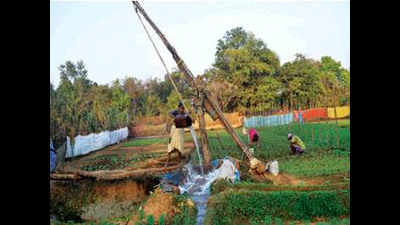Trending
This story is from February 17, 2019
Goa’s lost knowledge of water management

The ‘laat’ is a traditional system devised to lift water out of ponds called ‘honde’ that meet irrigation needs.
While parts of the state struggle with water shortage, some more severely than the others, a glimpse into the past shows that this situation is a more recent development one exacerbated by people moving away from their traditions.
Since the region receives rains only for three to four months, way back in time, our wise ancestors, like their contemporaries in the subcontinent, devised various ideas to harvest water to ensure that it was always aplenty and neither man nor biodiversity went thirsty.
To complement the water harvesting system, they also came up with simple but ingenious ideas to lift this water and use it for irrigation, making use of rustic lever systems. One such tradition in Goa is called the ‘laat’ and it meets autumnal irrigation needs for chillies, coriander and onions, among others.
Today, this tradition of making judicious use of water continues, but only in rural pockets of Tiswadi, Bardez, Pernem and Bicholim where the system continues to be maintained in an intelligent and sustainable manner.
The water that is lifted out is poured in irrigation channels dug in the earth. Operated by women, the lever system increases the ease of drawing water.
Rural women refer to the water harvesting and irrigation system in their folksongs.
Laat ge laatala Pani javuni patala Pani javuni patala Kay shevatichya betala
In this song, the ‘laat’ system finds reference as the women sing about irrigating and harvesting ‘shevantim’ (chrysanthemums).
Prafulla Zalmi, 64, from Bagwada in Pilgao, Bicholim says, “We still make use of ‘laat’ for irrigating our vegetables, chillies and onions. Wherever we find foliage growing, we dig a shallow and narrow well. Traditionally, we always dig ‘honde’ whereby flowing water accumulates and seeps into the earth.”
Anupama Gawade, 67, from Mandrem, says, “We manually operate the ‘laat’ to irrigate our seasonal crops.”
Since the region receives rains only for three to four months, way back in time, our wise ancestors, like their contemporaries in the subcontinent, devised various ideas to harvest water to ensure that it was always aplenty and neither man nor biodiversity went thirsty.
To complement the water harvesting system, they also came up with simple but ingenious ideas to lift this water and use it for irrigation, making use of rustic lever systems. One such tradition in Goa is called the ‘laat’ and it meets autumnal irrigation needs for chillies, coriander and onions, among others.
Today, this tradition of making judicious use of water continues, but only in rural pockets of Tiswadi, Bardez, Pernem and Bicholim where the system continues to be maintained in an intelligent and sustainable manner.
During the monsoon, when the land is amply fed with moisture, pits more than 3m in diameter are dug near fresh water bodies. These are locally referred to as ‘honde’. Then to pull the water out, a lever system is fashioned out of the trunk of an arecanut tree where one end is weighed down with a heavy stone. To the other end a bamboo stick with a bamboo basket is attached. When the stone weighs down, the bamboo basket rises filled the water collected from the ‘honde’. With time, the bamboo basket or ‘kolame’, as it is called, has come to be replaced with a tin box.
The water that is lifted out is poured in irrigation channels dug in the earth. Operated by women, the lever system increases the ease of drawing water.
Rural women refer to the water harvesting and irrigation system in their folksongs.
Laat ge laatala Pani javuni patala Pani javuni patala Kay shevatichya betala
In this song, the ‘laat’ system finds reference as the women sing about irrigating and harvesting ‘shevantim’ (chrysanthemums).
Prafulla Zalmi, 64, from Bagwada in Pilgao, Bicholim says, “We still make use of ‘laat’ for irrigating our vegetables, chillies and onions. Wherever we find foliage growing, we dig a shallow and narrow well. Traditionally, we always dig ‘honde’ whereby flowing water accumulates and seeps into the earth.”
Anupama Gawade, 67, from Mandrem, says, “We manually operate the ‘laat’ to irrigate our seasonal crops.”
End of Article
FOLLOW US ON SOCIAL MEDIA










